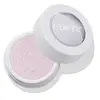What's inside
What's inside
 Key Ingredients
Key Ingredients

 Benefits
Benefits

No benefits
 Concerns
Concerns

 Ingredients Side-by-side
Ingredients Side-by-side

Dimethicone
EmollientIsononyl Isononanoate
EmollientTrimethylsiloxysilicate
EmollientDimethicone Crosspolymer
Emulsion StabilisingEthylhexyl Isononanoate
EmollientSilica
AbrasiveVinyl Dimethicone/Methicone Silsesquioxane Crosspolymer
Isopropyl Myristate
EmollientPhenoxyethanol
PreservativeStearalkonium Hectorite
Gel FormingEthylhexylglycerin
Skin ConditioningSynthetic Fluorphlogopite
Propylene Carbonate
SolventCI 75470
Cosmetic ColorantCI 77510
Cosmetic ColorantMica
Cosmetic ColorantCI 77891
Cosmetic ColorantDimethicone, Isononyl Isononanoate, Trimethylsiloxysilicate, Dimethicone Crosspolymer, Ethylhexyl Isononanoate, Silica, Vinyl Dimethicone/Methicone Silsesquioxane Crosspolymer, Isopropyl Myristate, Phenoxyethanol, Stearalkonium Hectorite, Ethylhexylglycerin, Synthetic Fluorphlogopite, Propylene Carbonate, CI 75470, CI 77510, Mica, CI 77891
Cyclopentasiloxane
EmollientAluminum Calcium Sodium Silicate
Calcium Sodium Borosilicate
Dimethicone
EmollientSynthetic Fluorphlogopite
Calcium Aluminum Borosilicate
Trimethylsiloxysilicate
EmollientIsododecane
EmollientBoron Nitride
AbsorbentC30-45 Alkyl Cetearyl Dimethicone Crosspolymer
EmollientCyclohexasiloxane
EmollientSilica
AbrasiveGlycine Soja Oil
EmollientMangifera Indica Seed Butter
Skin ConditioningCucumis Sativus Fruit Extract
EmollientDimethicone/Vinyltrimethylsiloxysilicate Crosspolymer
Alumina
AbrasivePhenoxyethanol
PreservativeDisteardimonium Hectorite
StabilisingPropylene Carbonate
SolventEthylhexylglycerin
Skin ConditioningTin Oxide
AbrasiveEpoxy Resin Coated Aluminum Powder
Cosmetic ColorantCI 77163
Cosmetic ColorantCI 77266
Cosmetic ColorantCI 42090
Cosmetic ColorantCI 77400
Cosmetic ColorantCI 77289
Cosmetic ColorantCI 77288
Cosmetic ColorantCI 77510
Cosmetic ColorantIron Oxides
CI 77742
Cosmetic ColorantMica
Cosmetic ColorantCI 16035
Cosmetic ColorantCI 77891
Cosmetic ColorantCI 77007
Cosmetic ColorantCI 19140
Cosmetic ColorantCyclopentasiloxane, Aluminum Calcium Sodium Silicate, Calcium Sodium Borosilicate, Dimethicone, Synthetic Fluorphlogopite, Calcium Aluminum Borosilicate, Trimethylsiloxysilicate, Isododecane, Boron Nitride, C30-45 Alkyl Cetearyl Dimethicone Crosspolymer, Cyclohexasiloxane, Silica, Glycine Soja Oil, Mangifera Indica Seed Butter, Cucumis Sativus Fruit Extract, Dimethicone/Vinyltrimethylsiloxysilicate Crosspolymer, Alumina, Phenoxyethanol, Disteardimonium Hectorite, Propylene Carbonate, Ethylhexylglycerin, Tin Oxide, Epoxy Resin Coated Aluminum Powder, CI 77163, CI 77266, CI 42090, CI 77400, CI 77289, CI 77288, CI 77510, Iron Oxides, CI 77742, Mica, CI 16035, CI 77891, CI 77007, CI 19140
Ingredients Explained
These ingredients are found in both products.
Ingredients higher up in an ingredient list are typically present in a larger amount.
This ingredient is used to impart a blue color. It is not water-soluble.
It goes by two different names:
1. Ferric Ferrocyanide: a synthetic dark blue pigment
2. Ferric Ammonium Ferrocyanide: a synthetic blue pigment, also called Prussian blue
In the EU, both of these colors must be labeled as 'CI 77510'.
Learn more about CI 77510Ci 77891 is a white pigment from Titanium dioxide. It is naturally found in minerals such as rutile and ilmenite.
It's main function is to add a white color to cosmetics. It can also be mixed with other colors to create different shades.
Ci 77891 is commonly found in sunscreens due to its ability to block UV rays.
Learn more about CI 77891Dimethicone is a type of synthetic silicone created from natural materials such as quartz.
What it does:
Dimethicone comes in different viscosities:
Depending on the viscosity, dimethicone has different properties.
Ingredients lists don't always show which type is used, so we recommend reaching out to the brand if you have questions about the viscosity.
This ingredient is unlikely to cause irritation because it does not get absorbed into skin. However, people with silicone allergies should be careful about using this ingredient.
Note: Dimethicone may contribute to pilling. This is because it is not oil or water soluble, so pilling may occur when layered with products. When mixed with heavy oils in a formula, the outcome is also quite greasy.
Learn more about DimethiconeEthylhexylglycerin (we can't pronounce this either) is commonly used as a preservative and skin softener. It is derived from glyceryl.
You might see Ethylhexylglycerin often paired with other preservatives such as phenoxyethanol. Ethylhexylglycerin has been found to increase the effectiveness of these other preservatives.
Mica is a naturally occurring mineral used to add shimmer and color in cosmetics. It can also help improve the texture of a product or give it an opaque, white/silver color.
Serecite is the name for very fine but ragged grains of mica.
This ingredient is often coated with metal oxides like titanium dioxide. Trace amounts of heavy metals may be found in mica, but these metals are not harmful in our personal products.
Mica has been used since prehistoric times throughout the world. Ancient Egyptian, Indian, Greek, Roman, Aztec, and Chinese civilizations have used mica.
Learn more about MicaPhenoxyethanol is a preservative that has germicide, antimicrobial, and aromatic properties. Studies show that phenoxyethanol can prevent microbial growth. By itself, it has a scent that is similar to that of a rose.
It's often used in formulations along with Caprylyl Glycol to preserve the shelf life of products.
This ingredient is a solvent. It helps dissolve active ingredients and alter the texture of products.
Propylene Carbonate is commonly used in makeup and with clay, such as montmorillonite or bentonite.
Studies show this ingredient to be safe for cosmetics. When it is undiluted, it can cause skin irritation. (It is always diluted in skincare and makeup). This ingredient is water-soluble.
Propylene Carbonate is created from propylene glycol and carbonic acid.
Learn more about Propylene CarbonateSilica, also known as silicon dioxide, is a naturally occurring mineral. It is used as a fine, spherical, and porous powder in cosmetics.
Though it has exfoliant properties, the function of silica varies depending on the product.
The unique structure of silica enhances the spreadability and adds smoothness, making it a great texture enhancer.
It is also used as an active carrier, emulsifier, and mattifier due to its ability to absorb excess oil.
In some products, tiny microneedles called spicules are made from silica or hydrolyzed sponge. When you rub them in, they lightly polish away dead skin layers and enhance the penetration of active ingredients.
Learn more about SilicaSynthetic Fluorphlogopite is the synthethic version of mica. It consists of fluorine, aluminum and silicate.
Synthetic Fluorphlogopite is used to add volume to products.
It is considered non-irritating on the skin.
Learn more about Synthetic FluorphlogopiteThis silicone is an emollient. Emollients create a thin film on the skin to prevent moisture from escaping.
It is not soluble in water and helps increase water-resistance in products.
According to a manufacturer, it can blend seamlessly with silicone oils, such as Cyclopentasiloxane.
Learn more about Trimethylsiloxysilicate